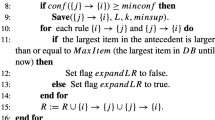Abstract
Mining association rules plays an important role in data mining and knowledge discovery since it can reveal strong associations between items in databases. Nevertheless, an important problem with traditional association rule mining methods is that they can generate a huge amount of association rules depending on how parameters are set. However, users are often only interested in finding the strongest rules, and do not want to go through a large amount of rules or wait for these rules to be generated. To address those needs, algorithms have been proposed to mine the top-k association rules in databases, where users can directly set a parameter k to obtain the k most frequent rules. However, a major issue with these techniques is that they remain very costly in terms of execution time and memory. To address this issue, this paper presents a novel algorithm named ETARM (Efficient Top-k Association Rule Miner) to efficiently find the complete set of top-k association rules. The proposed algorithm integrates two novel candidate pruning properties to more effectively reduce the search space. These properties are applied during the candidate selection process to identify items that should not be used to expand a rule based on its confidence, to reduce the number of candidates. An extensive experimental evaluation on six standard benchmark datasets show that the proposed approach outperforms the state-of-the-art TopKRules algorithm both in terms of runtime and memory usage.

















Similar content being viewed by others
References
Agrawal R, Imielminski T, Swami A (1993) Mining association rules between sets of items in large databases. In: Proceedings ACM international conference on management of data. ACM Press, pp 207–216
Agrawal R, Srikant R (1994) Fast algorithms for mining association rules. In: Proceedings of the 20th international conference on very large data bases, pp 487–499
Chuang KT, Huang JL, Chen MS (2008) Mining top-k frequent patterns in the presence of the memory constraint. VLDB J 17(5):1321–1344
Deng Z, Fang G (2007) Mining top-rank-k frequent patterns. In: ICMLC’07, pp 851–856
Deng ZH (2014) Fast mining top-rank-k frequent patterns by using node-lists. Expert Syst Appl 41(4):1763–1768
Deng ZH, Lv SL (2015) PrePost +: an efficient N-lists-based algorithm for mining frequent itemsets via children–parent equivalence pruning. Expert Syst Appl 42(13):5424–5432
Deng ZH (2016) DiffNodesets: an efficient structure for fast mining frequent itemsets. Appl Soft Comput 41:214–223
Fang G, Deng ZH (2008) VTK: vertical mining of top-rank-k frequent patterns. In: FSKD’08, pp 620–624
Fournier-Viger P, Wu C-W, Tseng VS (2012) Mining top-k association rules. In: Proceedings of the 25th Canadian conference on artificial intelligence AI (2012). Springer, LNAI 7310, pp 61– 73
Han J, Dong G, Yin Y (1999) Efficient mining of partial periodic patterns in time series database. In: ICDE’99, pp 106–115
Han J, Pei H, Yin Y (2004) Mining frequent patterns without candidate generation. In: Proceedings ACM international conference on management of data (SIGMOD’00, Dallas, TX), vol 8(1). ACM Press, pp 53–87
Han J, Wang J, Lu Y, Tzvetkov P (2002) Mining top-k frequent closed patterns without minimum support. In: ICDM’02, pp 211–218
Huynh-Thi-Le Q, Le T, Vo B, Le B (2015) An efficient and effective algorithm for mining top-rank-k frequent patterns. Expert Syst Appl 42(1):156–164
Le T, Vo B (2015) An N-list-based algorithm for mining frequent closed patterns. Expert Syst Appl 42 (19):6648–6657
Lucchese C, Orlando S, Perego R (2006) Fast and memory efficient mining of frequent closed itemsets. IEEE Trans Knowl Data Eng 18(1):21–36
Nguyen LTT, Trinh T, Nguyen NT, Vo B (2017) A method for mining top-rank-k frequent closed itemsets. J Intell Fuzzy Syst 32(2):1297–1305
Pasquier N, Bastide Y, Taouil R, Lakhal L (1999) Efficient mining of association rules using closed itemset lattices. Inf Syst 24(1):25–46
Pietracaprina A, Vandin F (2004) Efficient incremental mining of top-k frequent closed itemsets. In: Tenth international conference discovery science. Springer, Berlin, pp 275–280
Pyun G, Yun U (2014) Mining top-k frequent patterns with combination reducing techniques. Appl Intell 41(1):76–98
Pyun G, Yun U, Ryu KH (2014) Efficient frequent pattern mining base on linear prefix tree. Knowl-Based Syst 55:125–139
Sahoo J, Das AK, Goswami A (2015) An effective association rule mining scheme using a new generic basis. Knowl Inf Syst 43(1):127–156
Saif-Ur-Rehman, Ashraf J, Salam AHA (2016) Top-k miner: top-k identical frequent itemsets discovery without user support threshold. Knowl Inf Syst 48(3):741–762
Tzvetkov P, Yan X, Han J (2005) TSP: mining top-k closed sequential patterns. Knowl Inf Syst 7 (4):438–457
Vo B, Le B (2009) Mining traditional association rules using frequent itemsets lattice. In: International conference on computers & industrial engineering. IEEE Press, pp 1401–1406
Vo B, Le B (2011) Interestingness measures for association rules: combination between lattice and hash tables. Expert Syst Appl 38(9):11630–11640
Vo B, Hong TP, Le B (2012) DBV-miner: a dynamic bit-vector approach for fast mining frequent closed itemsets. Expert Syst Appl 39(8):7196–7206
Vo B, Hong TP, Le B (2013) A lattice-based approach for mining most generalization association rules. Knowl-Based Syst 45:20–30
Webb G I, Zhang S (2005) K-optimal rule discovery. Data Min Knowl Disc 10(1):39–79
Webb G I (2011) Filtered top-k association discovery. WIREs Data Min Knowl Discovery 1(3):183–192
You Y, Zhang J, Yang Z, Liu G (2010) Mining top-k fault tolerant association rules by redundant pattern disambiguation in data streams. In: International conference intelligent computing and cognitive informatics. IEEE Press, pp 470–473
Zaki MJ (2004) Mining non-redundant association rules. Data Min Knowl Disc 9(3):223–248
Acknowledgement
This work was carried out during the tenure of an ERCIM ‘Alain Bensoussan’ Fellowship Programme.
Author information
Authors and Affiliations
Corresponding author
Rights and permissions
About this article
Cite this article
Nguyen, L., Vo, B., Nguyen, L. et al. ETARM: an efficient top-k association rule mining algorithm. Appl Intell 48, 1148–1160 (2018). https://doi.org/10.1007/s10489-017-1047-4
Published:
Issue Date:
DOI: https://doi.org/10.1007/s10489-017-1047-4




